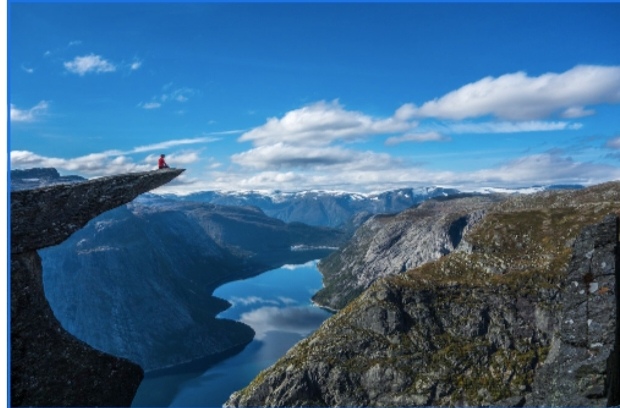Venturing into nature, always a delight" is a familiar saying among Norwegians. With a plethora of trails set in breathtaking landscapes, Norway stands as a hiker's haven. From verdant woodlands and deep fjords to majestic peaks, nature is always within reach in this scenic nation.
Why Hiking in Norway is Unmatched
Norway's vast, varied landscapes make it a dream destination for hikers. The country's mountainous wilderness is renowned worldwide, offering numerous peaks that promise memorable adventures. Hiking is deeply ingrained in Norwegian culture, reflected in the well-maintained and accessible trails. The principle of "allemannsretten," or the freedom to roam, allows everyone to pitch a tent or hang a hammock in designated areas, bringing them closer to nature.
With a myriad of trails, each with its own unique and captivating name, hikers can immerse themselves in Norway's extraordinary natural beauty.
Distinctive and Captivating Norwegian Trail Names
Norway's extensive trail network is thoughtfully named to aid navigation. Just as urban street names guide city dwellers, these trail names simplify mountain hiking. Norway's trails are not only functional but also carry intriguing names, enhancing the hiking experience. Among the many uniquely named trails, some offer particularly stunning vistas.
Sukkertoppen (Sugar Top): Echoing Rio de Janeiro's famous Sugarloaf Mountain, Norway's own Sukkertoppen lies near Ålesund. This 3.66 km hike offers splendid views of the surrounding mountains, city, and fjord.
Djevelporten (Devil’s Gate): In the Lofoten Islands, this trail leads to a striking rock formation. The ascent includes the Djeveltrappa, a 1,240-step stairway built by Sherpas, making Devil’s Gate accessible for various ages.
Laushornet (Loose Hornet) – 1,431 m: Overlooking the famed Geirangerfjord, Laushornet provides sweeping views of the fjord. Despite its quirky name, the hike is short and scenically rewarding.
Kattanakken: A detour en route to Briksdalsbreen, Kattanakken offers a less crowded alternative with magnificent views of Jostedalsbreen and Briksdalsbreen.
Trolltunga (Troll’s Tongue): A popular tourist draw, Trolltunga extends over the Hardangerfjord, resembling a troll's tongue and offering spectacular views.
Norway's Towering Peaks
Norway's picturesque mountains are a magnet for hikers. With 377 mountains exceeding 2,000 meters, there's ample space to avoid crowds. Jotunheimen National Park alone houses 23 of these towering peaks. Galdhøpiggen, at 2,469 meters, is a household name in Norway, often remembered through the mnemonic "2468 + 1." Here are Norway's five tallest mountains:
Galdhøpiggen – 2,469 meters
Glittertinden – 2,452 meters
Store Skagastøltind – 2,405 meters
Store Styggedalstind – 2,387 meters
Skardstind – 2,373 meters
Jotunheimen National Park is home to these giants, with Snøhetta in Dovrefjell ranking as the 24th highest in Norway.
Top Hiking Destinations Near Oslo
Norway's charm lies in its easy access to nature, even from urban centers. Oslo, the bustling capital, is a haven for outdoor lovers, with numerous hiking options reachable by public transport or car.
Nordmarka and Østmarka: Beloved by Oslo's residents, these areas boast well-kept trails winding through picturesque forests. They're perfect for hiking, biking, or leisurely walks, and feature several lakes ideal for water-based activities.
Vikerfjell: Just a two-hour drive from Oslo, Vikerfjell is the closest high mountain area to the city. It offers superb hiking in summer and extensive cross-country skiing trails in winter.
Mørkgonga: A scenic gorge near Oslo, Mørkgonga has become popular on social media. About an hour's drive from the city, it's a great spot for nature walks, berry picking, and swimming in Steinsfjorden.
After a day of exploring the trails near Oslo, consider a unique stay at riverside accommodation. This exceptional lodging offers a perfect blend of comfort and nature, allowing you to relax and rejuvenate amidst the serene Norwegian landscape.
Other Notable Hiking Spots in Norway
Beyond Oslo, Norway is dotted with stunning landscapes, each providing unique outdoor experiences amidst majestic mountains.
Rondane National Park: About four and a half hours from Oslo, this park is a prime hiking destination. Surrounded by peaks over 2,000 meters, it's also home to the challenging Rondane 2K marathon.
Lysefjorden: Known for its dramatic mountains and deep fjords, Lysefjorden is a tourist favorite. Besides famous sites like Preikestolen and Kjerag, it features Flørli, home to the world's longest wooden staircase, offering a distinct hiking experience.
De Syv Søstre (The Seven Sisters): South of Sandnessjøen in Helgeland, this mountain range comprises seven peaks. Hikers can tackle all seven or just one, with the full journey spanning 26 kilometers across peaks like Botnkrona and Grytfoten.
Mountain Region Tourist Attractions
Norway's mountain areas are not just about hiking; they also host popular tourist attractions.
Fløibanen in Bergen is a top tourist draw, offering a ride to the summit with stunning views. The Ulriken Cable Car is another highlight, providing panoramic vistas and a summit restaurant.
For thrill-seekers, Rjukan offers premier ice climbing on its frozen waterfalls. The Rjukan Climbing Park caters to all ages for more adventures. Rjukan, near Gaustatoppen, is also a UNESCO World Heritage site.
Conclusion
With its towering mountains, deep fjords, and expansive wilderness, Norway is a paradise for hikers. The country's well-marked trails cater to all, but hikers should be prepared for sudden weather changes. Essential gear includes a windproof jacket and reliable hiking boots, ensuring a safe and enjoyable Norwegian hiking experience.
The beauty of hiking in Norway lies in its accessibility and variety. Whether it's the challenging ascents in Jotunheimen, the tranquil walks along the fjords, or the forested paths in areas like Nordmarka and Østmarka near Oslo, there's something for every preference and skill level. The experience is enhanced by the country's commitment to outdoor life, embodied in the “allemannsretten” or “right to roam,” which invites everyone to respectfully enjoy and explore the natural world.


